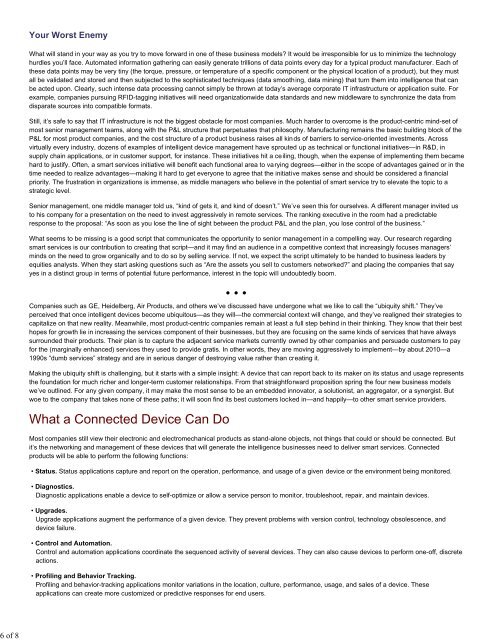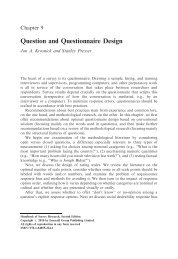Four Strategies for the Age of Smart Services - Courses
Four Strategies for the Age of Smart Services - Courses
Four Strategies for the Age of Smart Services - Courses
Create successful ePaper yourself
Turn your PDF publications into a flip-book with our unique Google optimized e-Paper software.
6 <strong>of</strong> 8<br />
Your Worst Enemy<br />
What will stand in your way as you try to move <strong>for</strong>ward in one <strong>of</strong> <strong>the</strong>se business models It would be irresponsible <strong>for</strong> us to minimize <strong>the</strong> technology<br />
hurdles you’ll face. Automated in<strong>for</strong>mation ga<strong>the</strong>ring can easily generate trillions <strong>of</strong> data points every day <strong>for</strong> a typical product manufacturer. Each <strong>of</strong><br />
<strong>the</strong>se data points may be very tiny (<strong>the</strong> torque, pressure, or temperature <strong>of</strong> a specific component or <strong>the</strong> physical location <strong>of</strong> a product), but <strong>the</strong>y must<br />
all be validated and stored and <strong>the</strong>n subjected to <strong>the</strong> sophisticated techniques (data smoothing, data mining) that turn <strong>the</strong>m into intelligence that can<br />
be acted upon. Clearly, such intense data processing cannot simply be thrown at today’s average corporate IT infrastructure or application suite. For<br />
example, companies pursuing RFID-tagging initiatives will need organizationwide data standards and new middleware to synchronize <strong>the</strong> data from<br />
disparate sources into compatible <strong>for</strong>mats.<br />
Still, it’s safe to say that IT infrastructure is not <strong>the</strong> biggest obstacle <strong>for</strong> most companies. Much harder to overcome is <strong>the</strong> product-centric mind-set <strong>of</strong><br />
most senior management teams, along with <strong>the</strong> P&L structure that perpetuates that philosophy. Manufacturing remains <strong>the</strong> basic building block <strong>of</strong> <strong>the</strong><br />
P&L <strong>for</strong> most product companies, and <strong>the</strong> cost structure <strong>of</strong> a product business raises all kinds <strong>of</strong> barriers to service-oriented investments. Across<br />
virtually every industry, dozens <strong>of</strong> examples <strong>of</strong> intelligent device management have sprouted up as technical or functional initiatives—in R&D, in<br />
supply chain applications, or in customer support, <strong>for</strong> instance. These initiatives hit a ceiling, though, when <strong>the</strong> expense <strong>of</strong> implementing <strong>the</strong>m became<br />
hard to justify. Often, a smart services initiative will benefit each functional area to varying degrees—ei<strong>the</strong>r in <strong>the</strong> scope <strong>of</strong> advantages gained or in <strong>the</strong><br />
time needed to realize advantages—making it hard to get everyone to agree that <strong>the</strong> initiative makes sense and should be considered a financial<br />
priority. The frustration in organizations is immense, as middle managers who believe in <strong>the</strong> potential <strong>of</strong> smart service try to elevate <strong>the</strong> topic to a<br />
strategic level.<br />
Senior management, one middle manager told us, “kind <strong>of</strong> gets it, and kind <strong>of</strong> doesn’t.” We’ve seen this <strong>for</strong> ourselves. A different manager invited us<br />
to his company <strong>for</strong> a presentation on <strong>the</strong> need to invest aggressively in remote services. The ranking executive in <strong>the</strong> room had a predictable<br />
response to <strong>the</strong> proposal: “As soon as you lose <strong>the</strong> line <strong>of</strong> sight between <strong>the</strong> product P&L and <strong>the</strong> plan, you lose control <strong>of</strong> <strong>the</strong> business.”<br />
What seems to be missing is a good script that communicates <strong>the</strong> opportunity to senior management in a compelling way. Our research regarding<br />
smart services is our contribution to creating that script—and it may find an audience in a competitive context that increasingly focuses managers’<br />
minds on <strong>the</strong> need to grow organically and to do so by selling service. If not, we expect <strong>the</strong> script ultimately to be handed to business leaders by<br />
equities analysts. When <strong>the</strong>y start asking questions such as “Are <strong>the</strong> assets you sell to customers networked” and placing <strong>the</strong> companies that say<br />
yes in a distinct group in terms <strong>of</strong> potential future per<strong>for</strong>mance, interest in <strong>the</strong> topic will undoubtedly boom.<br />
• • •<br />
Companies such as GE, Heidelberg, Air Products, and o<strong>the</strong>rs we’ve discussed have undergone what we like to call <strong>the</strong> “ubiquity shift.” They’ve<br />
perceived that once intelligent devices become ubiquitous—as <strong>the</strong>y will—<strong>the</strong> commercial context will change, and <strong>the</strong>y’ve realigned <strong>the</strong>ir strategies to<br />
capitalize on that new reality. Meanwhile, most product-centric companies remain at least a full step behind in <strong>the</strong>ir thinking. They know that <strong>the</strong>ir best<br />
hopes <strong>for</strong> growth lie in increasing <strong>the</strong> services component <strong>of</strong> <strong>the</strong>ir businesses, but <strong>the</strong>y are focusing on <strong>the</strong> same kinds <strong>of</strong> services that have always<br />
surrounded <strong>the</strong>ir products. Their plan is to capture <strong>the</strong> adjacent service markets currently owned by o<strong>the</strong>r companies and persuade customers to pay<br />
<strong>for</strong> <strong>the</strong> (marginally enhanced) services <strong>the</strong>y used to provide gratis. In o<strong>the</strong>r words, <strong>the</strong>y are moving aggressively to implement—by about 2010—a<br />
1990s “dumb services” strategy and are in serious danger <strong>of</strong> destroying value ra<strong>the</strong>r than creating it.<br />
Making <strong>the</strong> ubiquity shift is challenging, but it starts with a simple insight: A device that can report back to its maker on its status and usage represents<br />
<strong>the</strong> foundation <strong>for</strong> much richer and longer-term customer relationships. From that straight<strong>for</strong>ward proposition spring <strong>the</strong> four new business models<br />
we’ve outlined. For any given company, it may make <strong>the</strong> most sense to be an embedded innovator, a solutionist, an aggregator, or a synergist. But<br />
woe to <strong>the</strong> company that takes none <strong>of</strong> <strong>the</strong>se paths; it will soon find its best customers locked in—and happily—to o<strong>the</strong>r smart service providers.<br />
What a Connected Device Can Do<br />
Most companies still view <strong>the</strong>ir electronic and electromechanical products as stand-alone objects, not things that could or should be connected. But<br />
it’s <strong>the</strong> networking and management <strong>of</strong> <strong>the</strong>se devices that will generate <strong>the</strong> intelligence businesses need to deliver smart services. Connected<br />
products will be able to per<strong>for</strong>m <strong>the</strong> following functions:<br />
• Status. Status applications capture and report on <strong>the</strong> operation, per<strong>for</strong>mance, and usage <strong>of</strong> a given device or <strong>the</strong> environment being monitored.<br />
• Diagnostics.<br />
Diagnostic applications enable a device to self-optimize or allow a service person to monitor, troubleshoot, repair, and maintain devices.<br />
• Upgrades.<br />
Upgrade applications augment <strong>the</strong> per<strong>for</strong>mance <strong>of</strong> a given device. They prevent problems with version control, technology obsolescence, and<br />
device failure.<br />
• Control and Automation.<br />
Control and automation applications coordinate <strong>the</strong> sequenced activity <strong>of</strong> several devices. They can also cause devices to per<strong>for</strong>m one-<strong>of</strong>f, discrete<br />
actions.<br />
• Pr<strong>of</strong>iling and Behavior Tracking.<br />
Pr<strong>of</strong>iling and behavior-tracking applications monitor variations in <strong>the</strong> location, culture, per<strong>for</strong>mance, usage, and sales <strong>of</strong> a device. These<br />
applications can create more customized or predictive responses <strong>for</strong> end users.
















